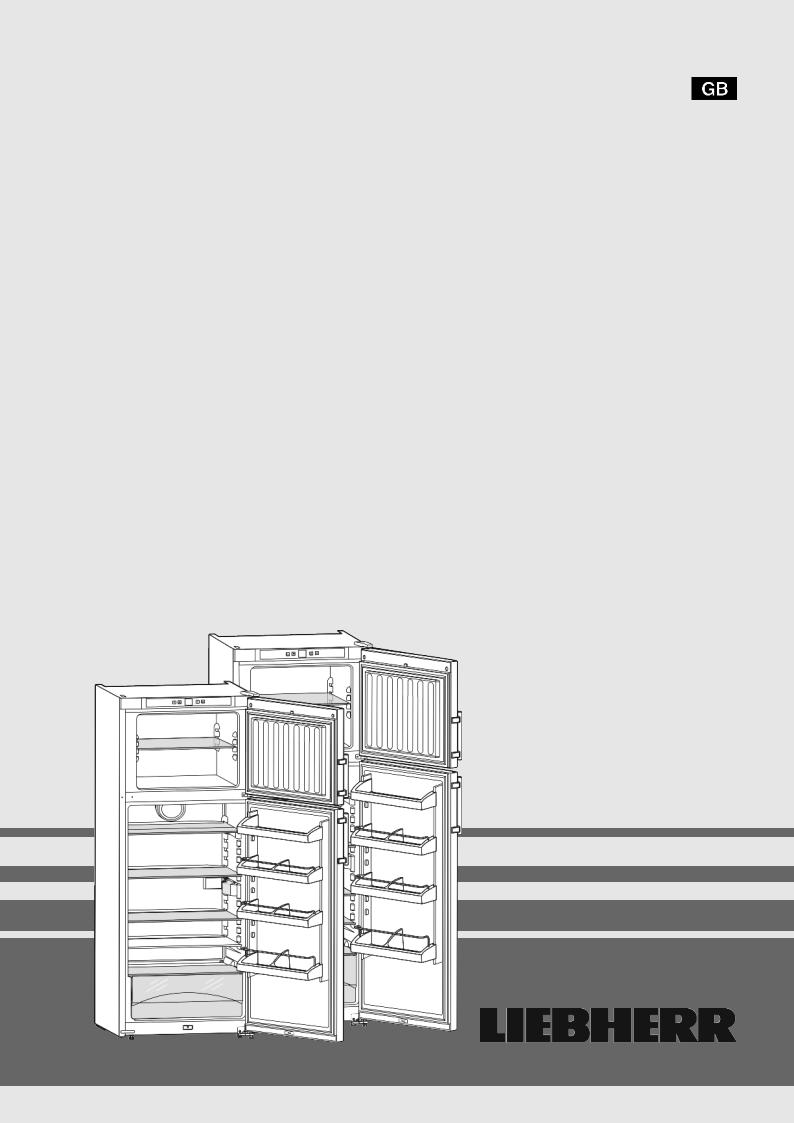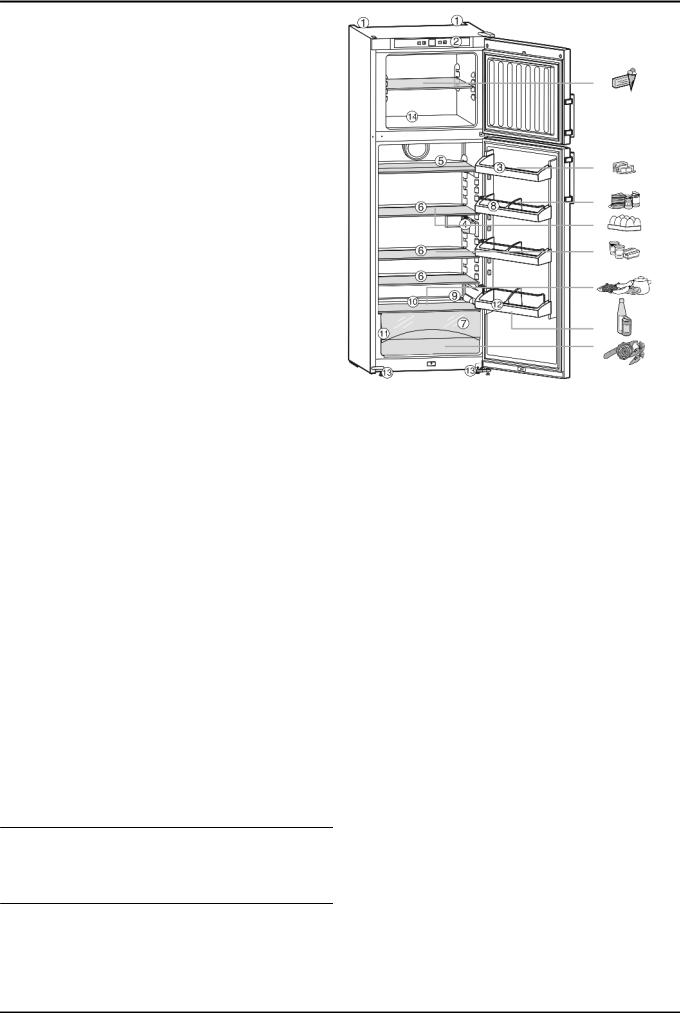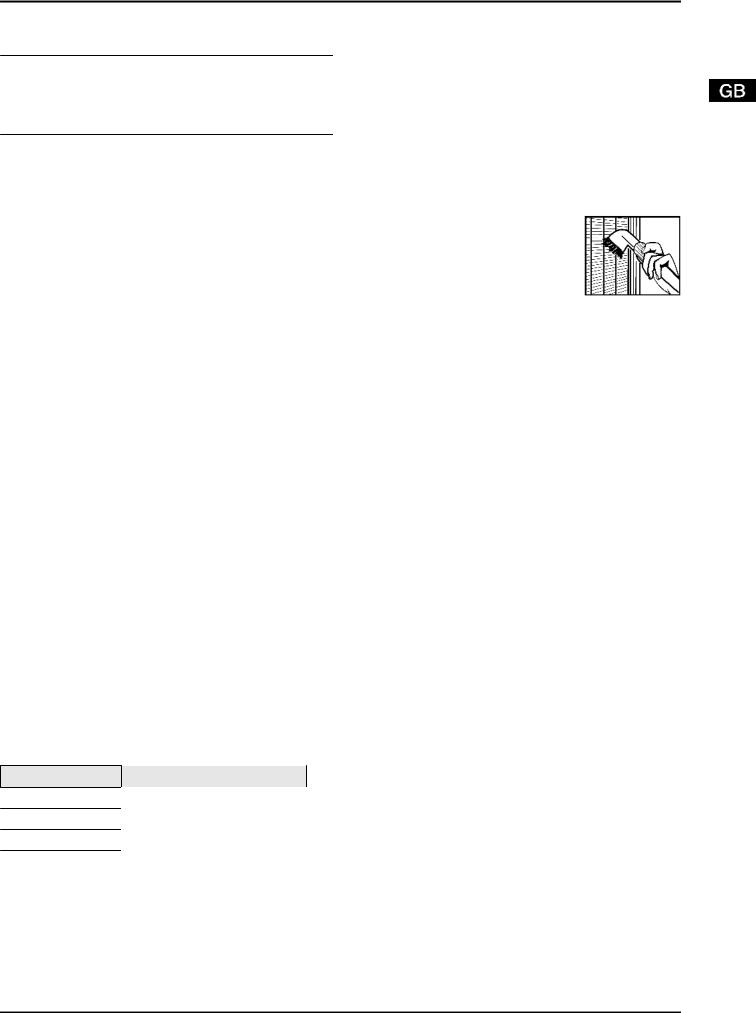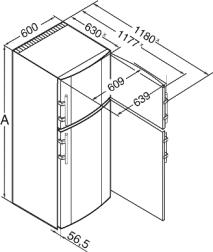Liebherr CTSL 3306, CTP 3016, CT 3306, CTPESF 3016, CTPESF 3316 Manual
...
Operating instructions
Combined fridge-freezer
071212 7082827 - 00
CT(P)(esf)(sl)30../33 ... 6

Appliance at a glance
Contents |
|
|
1 |
Appliance at a glance............................................ |
2 |
1.1 |
Overview of the appliance and equipment................ |
2 |
1.2 |
Range of appliance use............................................ |
2 |
1.3 |
Conformity................................................................ |
3 |
1.4 |
External dimensions of the appliance....................... |
3 |
1.5 |
Saving energy.......................................................... |
3 |
2 |
General safety information................................... |
3 |
3 |
Controls and displays........................................... |
4 |
3.1 |
Operating controls.................................................... |
4 |
3.2 |
Temperature display................................................. |
4 |
4 |
Putting into operation............................................ |
4 |
4.1 |
Transporting the appliance....................................... |
4 |
4.2 |
Installing the appliance............................................. |
4 |
4.3 |
Changing over the door hinges................................ |
5 |
4.4 |
Insertion into a row of kitchen units........................... |
7 |
4.5 |
Disposing of packaging............................................ |
7 |
4.6 |
Connecting the appliance......................................... |
7 |
4.7 |
Switching on the appliance....................................... |
8 |
5 |
Control.................................................................... |
8 |
5.1 |
Brightness of the temperature display...................... |
8 |
5.2 |
Child proofing........................................................... |
8 |
5.3 |
Refrigerator compartment........................................ |
8 |
5.4 |
Freezer compartment............................................... |
10 |
6 |
Maintenance........................................................... |
11 |
6.1 |
Manual defrosting..................................................... |
11 |
6.2 |
Cleaning the appliance............................................. |
11 |
6.3 |
Replacing the interior illumination with LED lamp..... |
11 |
6.4 |
Customer service..................................................... |
12 |
7 |
Malfunction............................................................. |
12 |
8 |
Decommissioning.................................................. |
13 |
8.1 |
Switching off the appliance....................................... |
13 |
8.2 |
Taking the appliance out of service.......................... |
13 |
9 |
Disposing of the appliance................................... |
13 |
The manufacturer works constantly on the further development of all the types and models. Therefore please understand that we have to reserve the right to make design, equipment and technical modifications.
To get to know all the benefits of your new appliance, please read the information contained in these instructions carefully.
The instructions apply to several models. Differences may occur. Text relating only to specific appliances is marked with an asterisk (*).
Instructions for action are marked with a  , the results of action are marked with a
, the results of action are marked with a  .
.
1 Appliance at a glance
1.1 Overview of the appliance and equipment
Note
u Place food inside the appliance as shown in the diagram. This allows the appliance to save energy during operation.
u Shelves, drawers and baskets are arranged for optimum energy efficiency on delivery.
Fig. 1 |
(8) Door rack, adjustable |
|
(1) |
Lifting handles (rear) |
|
(2) |
Operating controls |
(9) Drain opening |
(3) |
Butter and cheese |
(10) Coldest area |
(4) |
compartment |
(11) Type plate |
Interior light |
||
(5) |
Shelf, separable |
(12) Door rack for large bottles |
(6) |
Shelf, adjustable |
(13) Adjustable feet, front |
|
|
lifting handles, rear rollers |
(7) |
Vegetable bins |
for transport |
(14) Ice-cube tray |
||
1.2 Range of appliance use
The appliance is suitable solely for cooling food in a domestic environment or similar. This includes use in, for example
-in staff kitchenettes, bed and breakfast establishments,
-by guests in country homes, hotels, motels and other forms of accommodation,
-in catering and similar services in the wholesale trade
Use the appliance solely as is customary within a domestic environment. All other types of use are inadmissible. The appliance is not suitable for storing and cooling medicines, blood plasma, laboratory preparations or similar substances and products covered by the 2007/47/EC Medical Devices Directive. Misuse of the appliance can result in the stored products suffering harm or perishing. Furthermore, the appliance is not suitable for operation in potentially explosive atmospheres.
The appliance is set to operate within specific ambient temperature limits according to its
2

General safety information
climate rating. The correct climate rating for your appliance is indicated on the type plate.
Note
uCompliance with the ambient temperatures indicated is required, otherwise the cooling performance is reduced.
Climate |
for ambient temperatures of |
rating |
|
SN |
10 °C to 32 °C |
N |
16 °C to 32 °C |
ST |
16 °C to 38 °C |
T |
16 °C to 43 °C |
1.3 Conformity
The refrigerant circuit is tested for leakage. The appliance complies with the relevant safety regulations and EC Directives 2006/95/EC, 2004/108/EC, 2009/125/EC and 2010/30/EU.
Note for test institutions:
Tests are to be carried out according to the applicable standards and guidelines.
Preparation and testing of the appliances must be carried out taking the manufacturer's loading plans and the notes in the operating manual into account.
1.4 External dimensions of the appliance
 Fig. 2
Fig. 2
A (mm)
CTP(esf) 30.. |
1611 |
CTP(esf) 33.. |
1761 |
CT(esf)(sl) 33.. |
1761 |
x For appliances supplied with wall spacers, the measurement increases by 35 mm (see 4.2) .
1.5Saving energy
-Always ensure good ventilation. Do not cover ventilation openings or grille.
-Always keep fan louvres clear.
-Do not place appliance in areas of direct sunlight or next to a stove, heater or similar object.
- |
The energy consumption depends on the installation condi- |
- |
tions, e.g. the ambient temperature (see 1.2) . |
Keep the time the appliance is open to a minimum. |
|
- |
The lower the temperature setting, the higher the power |
- |
consumption. |
Store food logically. (see Appliance at a glance). |
|
- |
Ensure that all food is well packed and covered for storage. |
- |
This will prevent frost from forming. |
Remove food as needed in order that it does not warm too |
|
- |
much. |
First cool warm food to room temperature before storing it . |
|
- |
Defrost frozen food in the refrigerator. |
- |
If there is a thick layer of frost in the appliance: defrost the |
appliance.
Accumulated dust increases the energy consumption:
-Once a year, dust the refrigerating unit together with the metal grille of the heat exchanger at the back of the appliance.
2 General safety information
Danger for the user:
-This appliance can be used by children of 8 years old and over, and also by persons with restricted physical, sensory or mental capacity or lack of experience and knowledge, if they are supervised or have been instructed on safe use of the appliance and understand the resulting risks. Children must not be allowed to play with the appliance. Cleaning and user maintenance must not be carried out by children without supervision.
-When disconnecting the appliance from the supply, always take hold of the plug. Do not pull the cable.
-In the event of a fault pull out the mains plug or deactivate the fuse.
-Do not damage the mains power cable. Do not operate the appliance with a defective mains power cable.
-Have any repairs to or intervention in the appliance, and any change of the mains power cable, carried out by the customer service only or by other specialised personnel trained for the purpose.
-Only assemble, connect and dispose of the appliance according to the instructions.
-Please keep these instructions in a safe place and pass them on to any subsequent owners.
-Special-purpose lamps (incandescent lamps, LEDs, fluorescent tubes) in the appliance serve to illuminate the appliance interior and are not suited for room illumination.
Fire hazard:
-The refrigerant R 600a is environmentally friendly but flammable. Escaping refrigerant may ignite.
3

Controls and displays
•Do not damage the refrigerant circuit pipes.
•Do not allow naked flames or ignition sources to enter the appliance.
•Do not use any electrical appliances in the interior (e.g. steam cleaners, heaters, ice cream maker etc.).
•If refrigerant escapes: remove any naked flames or sources of ignition from the leakage area. Ventilate the room well. Notify the after-sales service.
-Do not store explosives or sprays using combustible propellants such as butane, propane, pentane, etc. in the appliance. To identify these spray cans, look for the list of contents printed on the can, or a flame symbol. Gases possibly escaping may ignite due to electrical components.
-Keep burning candles, lamps and other items with naked flames away from the appliance so that they do not set the appliance on fire.
-Please be sure to store alcoholic drinks or other packaging containing alcohol in tightly closed containers. Any alcohol that leaks out may be ignited by electrical components.
Danger of tipping and falling:
-Do not misuse the plinth, drawers, doors etc. as a step or for support. This applies particularly to children.
Danger of food poisoning:
-Do not consume food which has been stored too long.
Danger of frostbite, numbness and pain:
-Avoid lasting skin contact with cold surfaces or refrigerated/frozen food or take protective steps, e.g. wear gloves. Do not consume ice cream, water ice or ice cubes immediately and do not consume them too cold.
Danger of injury and damage:
-Hot steam can lead to injury. Do not use electrical heating or steam cleaning equipment, open flames or defrosting sprays to defrost.
-Do not use sharp implements to remove the ice.
Please observe the specific information in the other sections:
|
DANGER |
identifies a situation involving direct |
|
|
danger which, if not obviated, may |
|
|
result in death or severe bodily |
|
|
injury. |
|
WARNING |
identifies a dangerous situation |
|
|
which, if not obviated, may result in |
|
|
death or severe bodily injury. |
|
CAUTION |
identifies a dangerous situation |
|
|
which, if not obviated, may result in |
|
|
minor or medium bodily injury. |
|
NOTICE |
identifies a dangerous situation |
|
|
which, if not obviated, may result in |
|
|
damage to property. |
|
|
|
|
Note |
identifies useful information and tips. |
3 Controls and displays
3.1 Operating controls
(1) |
On/Off button |
(6) |
Fig. 3 |
SuperFrost symbol |
|||
(2) |
Adjustment button |
(7) |
Child lock symbol |
(3) |
Temperature display, |
(8) |
Ventilation symbol |
(4) |
fridge section |
(9) |
Menu symbol |
Ventilation button |
|||
(5) |
SuperFrost button |
|
|
3.2 Temperature display
The following are displayed in normal operation:
- |
the average cooling temperature |
The temperature display flashes: |
|
- |
the temperature setting is being changed |
The following displays indicate malfunction. Possible causes and corrective action (see Malfunction).
- F0 to F9
4 Putting into operation
4.1 Transporting the appliance
 CAUTION
CAUTION
Risk of injury and danger of damage as a result of incorrect transport!
u Transport the appliance in a packed condition. u Transport the appliance upright.
u Do not transport the appliance without assistance.
4.2 Installing the appliance
 WARNING
WARNING
Fire hazard due to dampness!
If live parts or the mains lead become damp this may cause short circuits.
u The appliance is designed for use in enclosed areas. Do not operate the appliance outdoors or in areas where it is exposed to splash water or damp conditions.
4

Putting into operation
 WARNING
WARNING
Risk of fire due to short circuit!
If the mains cable/connector of the appliance or of another appliance touch the rear of the appliance, the mains cable/ connector may be damaged by the appliance vibrations, leading to a short circuit.
u Stand the appliance so that it is not touched by connectors or main cables.
u Do not plug the appliance or any others into sockets located near the rear of the appliance.
 WARNING
WARNING
Fire hazard due to refrigerant!
The refrigerant R 600a is environmentally friendly but flammable. Escaping refrigerant may ignite.
u Do not damage the piping of the refrigeration circuit.
 WARNING
WARNING
Fire hazard and danger of damage!
u Do not place appliances emitting heat e.g. microwaves, toasters etc. on the appliance!
 WARNING
WARNING
Blocked ventilation openings pose a risk of fire and damage!
u Always keep the ventilation openings clear. Always ensure that the appliance is properly ventilated!
NOTICE
Risk of damage due to condensate!
u Do not install the appliance directly alongside a further refrigerator/freezer.
q In the event that the appliance is damaged, contact the supplier immediately before connecting to the mains.
q The floor at the site must be flat and level.
q Do not install the appliance in a location where it is exposed to direct radiation of the sun, next to a cooker, heater and similar.
q Always stand the appliance backed directly to the wall using the enclosed wall spacers (see below).
q The appliance may be moved only when it is empty. q Do not install the appliance without assistance.
q Standard EN 378 specifies that the room in which you install your appliance must have a volume of 1 m2 per 8 g of R 600a refrigerant used in the appliance. If the room in which the appliance is installed is too small, a flammable gas-air mixture may form in the event of a leakage in the refrigeration circuit. The quantity of refrigerant used in your appliance is indicated on the type plate on the inside of the appliance.
u Detach the connecting cable from the rear of the appliance, removing the cable holder at the same time because otherwise there will be vibratory noise!
u Remove the protective film from the outside of the appliance.*
NOTICE
The stainless steel doors are finished with a high quality surface coating and must not be treated with the enclosed care product,
as otherwise the surface coating will be damaged.
u Please only use a soft clean cloth to wipe the coated door surfaces.
u Only use a stainless steel care product on the stainless steel side walls, applying it evenly in the direction of polishing. Subsequent cleaning will then be easier.
u Use only a soft clean cloth to wipe side walls and door surfaces with a paint finish.
uRemove the protective film from the decorative trims.
uRemove all transit supports.
The spacers supplied with some appliances must be used to achieve the stated energy consumption. These will extend the depth of the appliance by approx. 35 mm. The appliance is fully functional if the spacers are not used, but does have a slightly higher energy consumption.
u In the case of an appliance with enclosed wall spacers, mount the wall spacers on the back of the appliance at the top left and right.
uDispose of packaging material (see 4.5) .
uAlign the appliance so that it stands firmly and on a level by applying the accompanying spanner to the adjustableheight feet (A) and using a spirit level.
uThen support the door: Extend the adjustable foot at the turn hinge (B) until it rests on the floor and then make a further 90° turn.
Note
u Clean the appliance (see 6.2) .
If the appliance is installed in a very damp environment, condensate may form on the outside of the appliance.
u Always see to good ventilation at the installation site.
4.3 Changing over the door hinges
You can change over the door hinges if necessary.
Ensure that the following tools are to hand:
q Torx® 25
q Torx® 15 q Screwdriver
q Cordless screwdriver, if necessary
q Second person for fitting work, if needed
4.3.1 Detaching the upper door
Note
u Remove any food from the door racks before removing the door, so that no food falls out.
5
